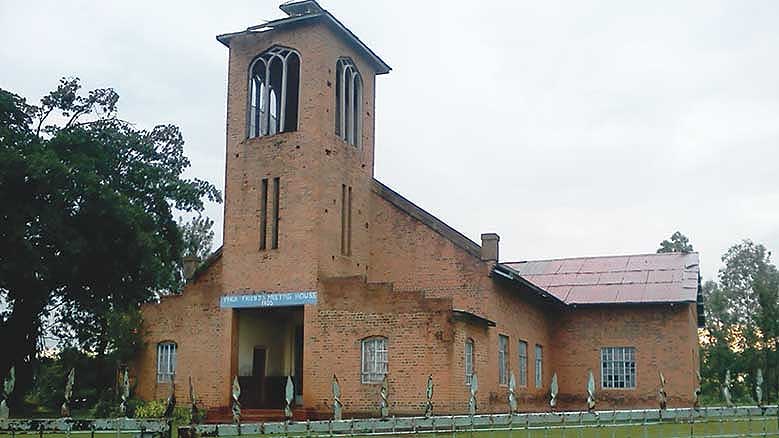
The Founding of the Mission in Kaimosi, Kenya
The story of the Kaimosi mission, founded in 1902 in western Kenya, is often told and much romanticized. Almost nothing has been published, however, that tells the story from the African point of view, and we are left with rather propagandistic accounts reflecting the viewpoint of missionaries and aimed at an audience of North American supporters. Even so, these accounts may be instructive, and for the purposes of this article, I am relying on a booklet titled The Friends Africa Industrial Mission, published in 1905 by the Friends Africa Industrial Mission, three years after the first arrival of the missionaries. There’s a breathless excitement to the tone of this booklet. The introduction states, “History is being made so rapidly on our station at Kaimosi that before the reader has completed this book, much might be added to the information herein contained.”
The movement began when a group of young Friends from what is now Malone University, a Quaker college in Canton, Ohio, organized the Friends Africa Industrial Mission by traveling extensively among North American yearly meetings in 1900 and 1901 to solicit funds and volunteers to form a committee. The purpose of the effort was to evangelize among the Kavirondo (now Luhya) tribe in British-occupied East Africa while also teaching industrial skills, so that any new church could be financially self-supporting from the beginning.
By February 1901, there were 20 young Friends with a leading to go to Kenya as missionaries. The committee sent three young men as “prospectors” to find a suitable location for an industrial mission. They set off in April 1902; spent a month raising support among British and Irish Friends; and then sailed to Mombasa, landing at the end of June. They traveled by the newly completed railroad to its terminus in Kisumu and began prospecting in the western highlands for a location that would meet the particular requirements of an industrial mission.
In August 1902, when two of the three were too sick to continue, they stumbled upon what is now Kaimosi, a stunningly beautiful, well-watered, fertile, and forested location; they perceived that it was “the place of God’s own choosing.” They purchased 858 acres from the British government for 64 cents per acre.
Of course, we have to acknowledge that the British government had no moral right to sell this land. From the perspective of our young Friends, however, the testimony of “fair dealing” was important, and they were glad to pay for, rather than seize, land for the mission.
In July 1903, the second group of missionaries joined the original three, including a medical doctor, a nurse, two women, and a baby. In 1904 Cherubini Matolas was sent to work alongside the missionaries as a “native helper” from the Friends Industrial Mission in Pemba, Zanzibar (under London Yearly Meeting). Cherubini took on responsibility for most of the teaching and preaching. Also in 1904, Emory and Deborah Rees joined the mission as linguists and Bible translators. The Reeses had already been in Africa for four years, having previously been sent by Vermillion Grove Quarterly Meeting in Illinois as missionaries to Zulu miners in Johannesburg, South Africa. In a very short time, the basic pattern of the mission took shape in its four departments: industrial, medical, educational, and evangelistic. In all things, “evangelization of the heathen” was the primary goal, but the approach taken was unusually holistic for its time. I want to briefly describe the four departments before drawing conclusions about the distinctives of Quaker mission work in its settled or institutional form.
In a very short time, the basic pattern of the mission took shape in its four departments: industrial, medical, educational, and evangelistic.
Industrial
The Kaimosi missionaries were exceedingly hardworking and instituted as diversified a program as they could manage, including constructing homes and mission buildings; operating a sawmill; subsistence and commercial agriculture; making a dam and sluiceway; brickmaking; road building; bridge building; tailoring; fine carpentry; milling of grain; and before long, a printing press and hydroelectric power generation system. The 1905 booklet notes that the local people were already expert ironworkers before they came into contact with the British or Americans.
The concept of an industrial mission was considered very progressive at that time. Rather than focus solely on the eternal salvation of African souls and the establishment of a church, the mission activity was centered around vocational training and job creation. In 1901, the British authorities had instituted a “hut tax” in order to force Africans into the settler-colonial labor market. Since working on settler plantations was so unpleasant and dehumanizing, very few Africans had any desire to seek that work, and an acute labor shortage in the colony developed. The hut tax was designed to force every homestead to send one adult to work on the plantations in order to solve the labor shortage. Yet it was a miserable life. The mission did everything they could to help Africans avoid being swept into the exploitative settler plantation economy or forced into urban migration, such as by providing jobs with a living wage in the village context.
The industrial department provided significant income for the mission as well as met all of the practical needs of the community and made it economically independent of donations from America. It was also noted that employment in one of the mission’s many industries provided a work environment with dignity, respect, and a constant Christian influence. The 1905 booklet notes that casual conversation while working side by side in manual labor proved a much more effective form of evangelism than formal preaching, and the missionaries made a point of working alongside Africans, not standing apart as overseers. This focus on work certainly contains patronizing overtones of the Protestant ethic of hard work and self-reliance as being constitutive of a Christian life with dignity, but there is also a commitment to the integration of the gospel that is a Quaker distinctive. The booklet says, in defense of the industrial mission concept, that “the most powerful preaching is the daily living.”
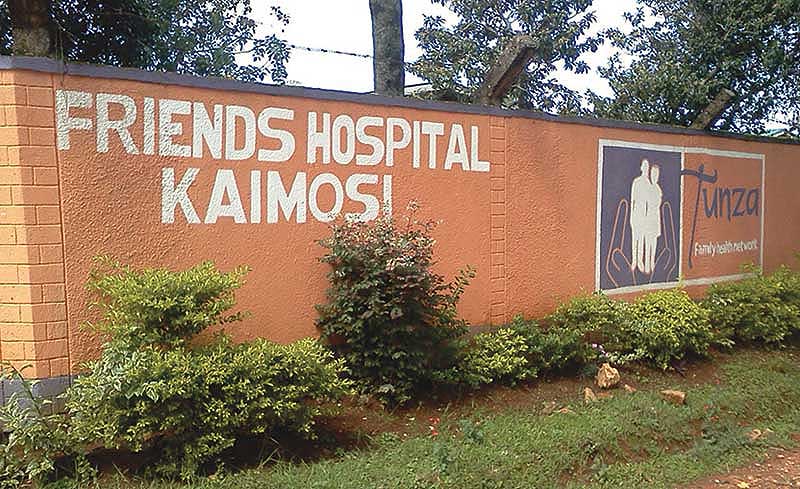
Today a third of Kenya’s healthcare is provided by mission facilities, especially in remote, underserved, or marginalized communities.
Medical
Ten weeks after arriving in Kaimosi, the team wrote to the committee back home asking for a medical doctor to be sent, because the local community wanted the mission to provide these much-needed services. Elisha and Virginia Blackburn, a married doctor and nurse pair, entered Kaimosi in July 1903 to find a long queue of patients anxiously awaiting their arrival. The most common ailments among the local community were malaria, plague, dysentery, smallpox, snakebite, jiggers, skin infections, and upper respiratory illness. Hospitals were built at Kaimosi (1917) and Lirhanda (1912), and a nursing school was established in 1925. The high demand for healthcare services made their establishment one of the most important activities of the mission—a fact that continues to be true today, as a third of Kenya’s healthcare is provided by mission facilities, especially in remote, underserved, or marginalized communities.
Quaker schools were important pioneers in several respects, including education for girls and the inclusion of subjects like agriculture and vocational training in an academic school curriculum.
Educational
The Friends Africa Industrial Mission booklet states, “It is the strong conviction of all missionary workers that the greater part of the evangelization of the heathen must be done by native evangelists.” In other words, from the very beginning, the mission assumed that the most effective communication of the gospel is not cross-cultural but is conducted by Africans themselves. Therefore there was a strong emphasis on equipping the earliest converts to be teachers and preachers. At the time, the local language had no written form, and the local people had very little knowledge of Swahili, being far from the coast. The Reeses and their African colleagues worked painstakingly to develop a written form of the local language, to write school books, to translate religious tracts and songs, and to translate the entire New Testament by 1925. Literacy was considered an essential part of Christian conversion for every new believer, so that they could read the Bible for themselves. By 1911 there were ten schools with 500 pupils. By 1916 there were 32 schools. In 1922 there were 77 schools with a total enrollment of 5,000 pupils, both boys and girls. In 1922 an “advanced” school was opened to provide secondary school education for those with an academic interest. Friends education was practical in nature and therefore quite distinct from the “classical” British education offered by other missions. (The colonial government did not offer education of any kind for Africans.) Quaker schools were important pioneers in several respects, including education for girls and the inclusion of subjects like agriculture and vocational training in an academic school curriculum. Today, there are nearly 2,000 Friends schools in Kenya, and this remains a very significant part of the work of every local church, and the work for which Friends are most widely known among the general population.
The sharing of the gospel was always the mission’s fundamental purpose, and all other activities served that end.
Evangelistic
The sharing of the gospel was always the mission’s fundamental purpose, and all other activities served that end. According to the 1905 report, daily morning devotions were attended by all 60 people living and working on the compound. The first convert was Ahonya, Arthur Chilson’s household servant. Although there were few converts in the first few years, the services were attended by hundreds, and as the language work progressed, the rate of conversion increased. The local chiefs were very interested in learning about this new faith and expressed interest in conversion. (It can be assumed that there was some mixed motive, considering White missionaries would have had considerable social capital in the British colony.) From the very beginning, the church work was entirely self-supporting, as every member was expected to tithe, and the church grew very rapidly after its initial slow start.
There’s an interesting passage about conversation in the 1905 booklet that I will quote at some length:
The number of converts has not been large, but those that have been reported have shown a radical change in their lives and commendable courage and zeal. As the natives are so ready to mimic and to grasp the form without the vital principle, it has been the policy of the mission to make sure that a person was truly in earnest before he should be reckoned among the converts. Instead of making it easy for them and urging them to publicly confess Christ, the reverse is the rule. They are urged to accept Him and an opportunity is given to tell of what has been done for them, but every step is watched and carefully guarded lest the cause of Christ be brought into disrepute by some who have the name to live but whose lives would put the lie to their profession.
While we may feel uncomfortable today by this focus on conversion evangelism, I find it interesting that the early Kaimosi missionaries fully expected the work of Christ in the hearts of Africans to be just as profound as it was in their own hearts. They did not have a double standard about the nature of Quaker faith and were very cautious about superficial religiosity and conversions motivated by a desire to gain from association with missionaries. They looked for the sustained testimony of a changed life, just as the early Friends did when distinguishing between true faith and the outward profession of it.
Having described the early Kaimosi mission, I hope we can draw three principles of enduring relevance for settled or institutional Quaker missions:
Service to mind, body, spirit, and community. The holistic nature of the Kaimosi mission was unique in its time and in contrast to other Christian missions; it is a reflection of the Quaker understanding that faith and life are fully integrated. The whole person and the whole community are served through a diverse program that includes schools, hospitals, churches, and job creation. Even today, this is the model of ministry found in frontier Friends missions such as Turkana and Samburu, in the northern desert regions of Kenya.
Local ownership and local prioritizing. Certainly the Kaimosi missionaries were products of their time and representatives of a racist paradigm, but they did feel it important to listen to the needs of the local community, such as when they prioritized healthcare in their first expansion of work. They also made sure that every church was self-governing, with local leadership, from the very beginning, so there was never a phase of “handing over” the church to the people, as in other denominational missions that had sent pastors to the field. East Africa Yearly Meeting became an independent yearly meeting and a full member of Friends United Meeting in 1947, 16 years before Kenyan independence and decades before other denominations granted mission-originated churches equal status.
Addressing issues of justice and equality in the context. With 20/20 hindsight, we see how complicit the Kaimosi missionaries were in the colonial structures, but in their context, they had a radical commitment to the integrity of the local community and to protecting it from exploitation in the settler-colonial economy. And the Quaker testimony of equality between women and men created opportunities for women in all spheres, liberating them from some of the more egregiously sexist aspects of indigenous culture. All of the women in the mission held full-time professional responsibilities and were considered equal partners in the work, and they participated in important networks with local women that have had a lasting impact on Luhya culture, as can be seen in the strength of the United Society of Friends Women organizations in Kenya today.
(A list of seven principles for itinerant Quaker mission, to accompany these principles for settled mission, can be found in the full text of my 2019 Michener Lecture, published by Southeastern Yearly Meeting.)
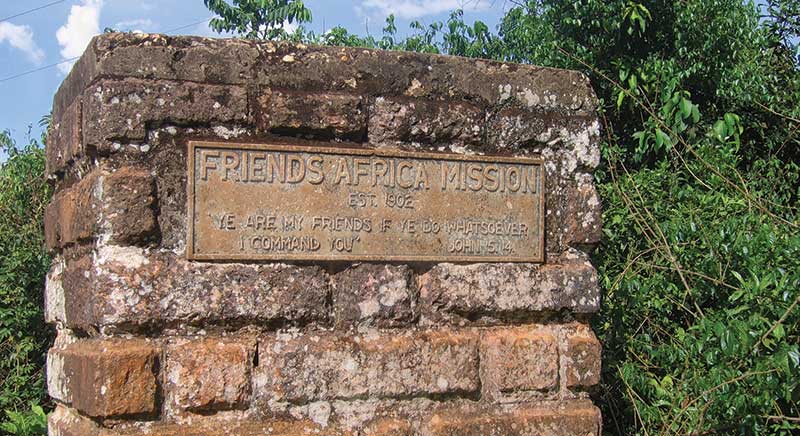
Looking back on the history of the Western missionary project in Africa, we are rightly disturbed that, in many places and in deeply insidious ways, missions were closely allied with colonizing political power, resource-grabbing economic power, and community-fracturing cultural power. Friends were not exempt from these patterns. Today, Friends from Western countries and Friends from African countries both stand in need of a reckoning and healing from the profound distortions of colonialism. And yet, by avoiding the temptation to judge the past by our contemporary standards, we can lift up the faithful leadings of God in the work of the Friends Africa Industrial Mission and celebrate its legacy in the vibrant and holistic African Quakerism of today.


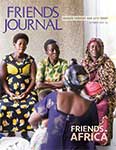
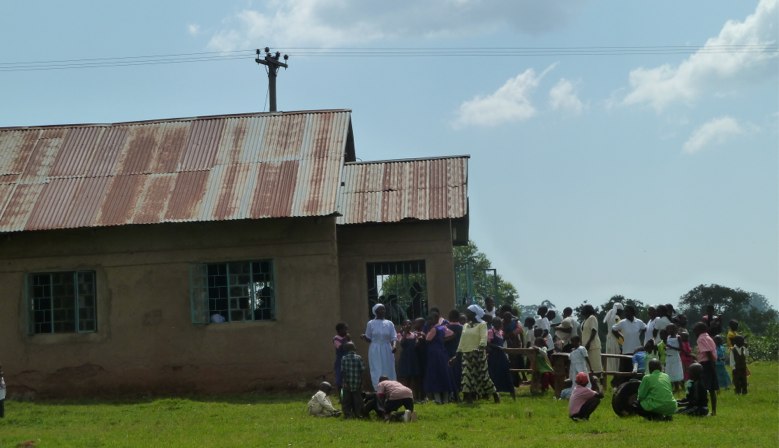
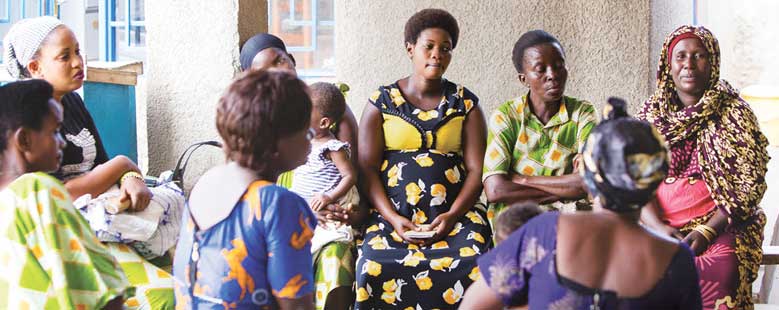
This is a well researched article. Perhaps we should now have a history of each yearly meeting. It could be interesting too
This is a great article to remind the African yearly meetings of the motive the the Industrial mission was set up. Self-sustainance and the work of Christ not to come to disrepute
This documentary has given me a clear picture of sacrificial work done by our fore Fathers , leading to the present quakerism
Very educative indeed. Is the power station still operating?
I guess the anti-colonial theme is prescient today!
We should also remember that when British East Africa came into being (1880s) slavery was still ongoing (Swahili and Kamba primarily). Female Genital Mutilation was normalised in almost all tribes of Kenya and there were approximately 0 children attending school. At the time the British Colony of Kenya ended (1920-1963) there were 840,000 children attending elementary school. This was a Herculean task accomplished with the minor interruption of two world wars!
My thanks to the Missionaries and Educators of that period!
Am where I am now because of the friends church, my grandmother.. the late pastor Lenah Kidambaya Vuguzwa trained trained here.. She Pastore until her demise. She taught me friends Christian values and systems. am very grateful to be associated with the kaimos friends church.i long to one day become pastor just like my grandmother was. To all who are aspiring to be friends of friends church I welcome you to this noble family.to God be the glory now, and forever emen.
Kaimosi my motherland. A lot has been said and done here. My interest would be in the lives and stories of these great heroes of Salvation who upon landing in Kaimosi made it their home, worked and stayed on to die in a foreign land and are buried in the Cemetery at Kaimosi. Did they leave any relatives behind? Did they write a book?any correspondences back home? a memoir? I would like to link up with the relatives of these Missionaries and maybe see what good can come out of their sacrifice for our People.
1. Emory and Deborah Rees
2. Elisha and Virginia Blackburn
3.